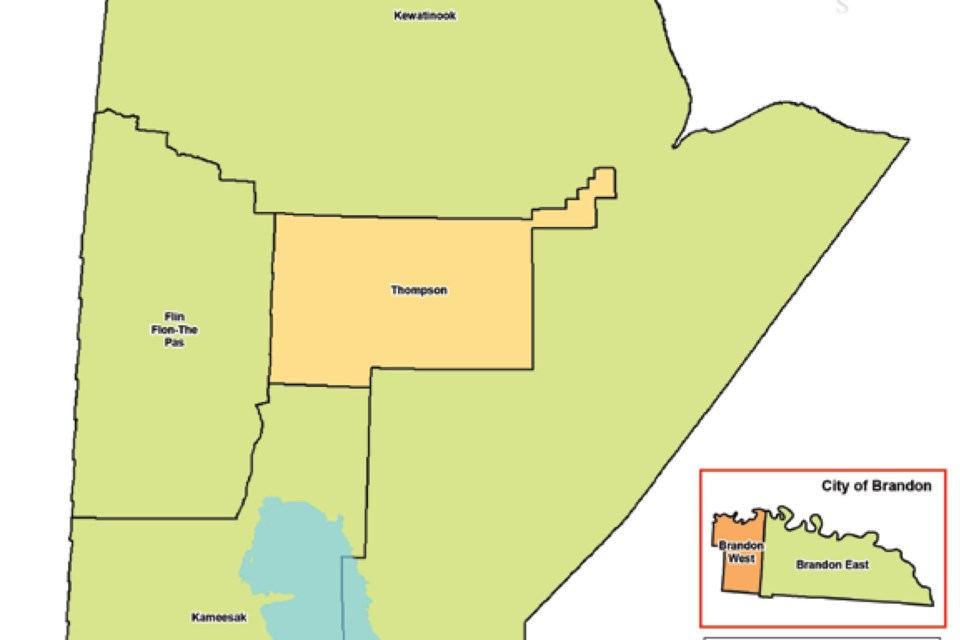The Manitoba Electoral Boundaries Commission’s proposal to add Gillam and Nelson House to the Thompson constituency for the 2020 election as part of an overhaul of all 57 of Manitoba’s electoral division could have some interesting consequences for the current MLA, the first Progressive Conservative candidate to hold the riding since the start of the 1980s.
Thompson MLA Kelly Bindle won the 2016 general election by less than 200 votes over the incumbent NDP candidate Steve Ashton, who had held the seat since 1981. And while the addition of Gillam and Nelson House to the Thompson electoral division wouldn’t necessarily be enough to put his chances of winning a second term in peril, it would have made it a closer race last time around, reducing Bindle’s margin of victory to 87.
In 2016, Gillam voted overwhelmingly in favour of the NDP’s Keewatinook candidate Eric Robinson, who captured 100 ballots there, compared to 54 for PC candidate Edna Nabess and 37 for Liberal candidate Judy Klassen, who ended up winning the seat.
In Nelson House, however, it was Liberal Leslie Beck who was the favoured candidate, collecting 151 votes to 62 for NDP candidate Tom Lindsey, who won the election, and 10 for Angela Enright of the Progressive Conservatives.
If the 2016 results from Gillam and Nelson House are added to the totals for the Thompson constituency, Progressive Conservative candidates would have taken 1,776 ballots – only 64 more than Bindle got in Thompson – while NDP candidates would have collected 1,689 – 162 more than Ashton got in Thompson, an increase of more than 10 per cent, while Liberal candidates would have received 826, about three-quarters of which were cast in Thompson for candidate Inez Vystrcil-Spence.
Combined turnout for Thompson, Nelson House and Gillam combined would have been about 33 per cent of the 12,881 eligible voters, lower than the actual turnout of about 34 per cent in Thompson but considerably higher than the actual turnout of about 23 per cent in Gillam and only 11 per cent in Nelson House.
In order to have equalled the total of the PC candidates, NDP candidates in Thompson as well as Gillam and Nelson House would only have needed to receive about five per cent more votes, which equals out to about two per cent of the total of 4,300 people who actually voted. If the PCs can increase the number of votes they receive in Thompson, the source of more than 90 per cent of Bindle’s 2016 votes, holding onto the seat would be easier, as it would if they drastically increased their fairly dismal showing in Nelson House and Gillam and most other outlying communities that are currently part of the Thompson riding. Another potential wildcard is whether Nelson House voters’ preference for the Liberals was based on the party platform or simply on the personal popularity of the 2016 candidate. For the NDP, the question will be whether the votes their candidates receive will remain as high as they were when they are not being cast for incumbents who are also members of the governing party and cabinet.
The one consolation for all three parties with seats in the Manitoba Legislature is that there is plenty of room for improvement, given that nearly twice as many eligible voters didn’t cast ballots as those who did. In the case of the NDP, for example, convincing well below one per cent of the total number of eligible voters would have been enough to win them the seat in 2016 if Gillam and Nelson House had been part of the Thompson constituency and their voting patterns had remained consistent.
The commission is proposing to add one new electoral division in Winnipeg and combine parts of The Pas and Flin Flon constituencies into one with remaining portions being added to the Keewatinook division and a new division called Kameesak, which would also include the northern portion of the current Swan River constituency. These changes would bring northern constituencies within less than 10 per cent above or below the electoral division target population of about 22,500, which is derived by dividing the total population of Manitoba by the current number of electoral divisions. Divisions south of the 53rd parallel can deviate by 10 per cent above or below the target population and those to the north can deviate by up to 25 per cent. Keewatinook is currently about 20 per cent below it and Thompson about 13 per cent while The Pas is less than two per cent below it. Flin Flon, however, is 30 per cent below the quotient based on 2008 census numbers. Thompson would be about 4.5 per cent below the target population after being adjusted to include Gillam and Nelson House.
Public hearings will be held on the proposed changes, which also include adjusting the size and boundaries of and changing the names of electoral divisions in the southern and western areas of Manitoba. In Churchill, a meeting will be held at 10 a.m. Sept. 11 in the overpass, while at 5 p.m. that day there will be another hearing at the Best Western Hotel in Thompson. On Sept. 12, there will be a meeting at noon at the Victoria Inn in Flin Flon and at 5 p.m. at the Sam Waller Museum in The Pas. Following those hearings, the commission will complete a final report with finalized electoral divisions that will be submitted to the lieutenant-governor and the speaker of the Legislative Assembly by Dec. 31 of this year.




